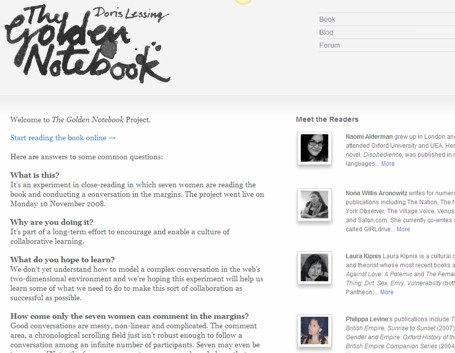
I’ve been involved in a discussion lately about different types of reading. Most people have agreed that reading a novel is very different to reading a website or anything else online. Some people think that deep thinking and understanding are becoming extinct since reading online has distracted a large part of the population. People are concerned that online reading is superficial, and that commenting revolves around less than challenging subject matter.
Well, today I discovered a very interesting project which combines serious literature with the trappings of online interaction. It’s called The Golden Notebook project.
Doris Lessing’s The golden notebook was digitised by HarperCollins. The book was allowed to be reproduced in digital form in its entirety without any cost.
Here is some information from the website:
What is this?
It’s an experiment in close-reading in which seven women are reading the book and conducting a conversation in the margins. The project went live on Monday 10 November 2008.
Why are you doing it?
It’s part of a long-term effort to encourage and enable a culture of collaborative learning.
What do you hope to learn?
We don’t yet understand how to model a complex conversation in the web’s two-dimensional environment and we’re hoping this experiment will help us learn some of what we need to do to make this sort of collaboration as successful as possible.
How come only the seven women can comment in the margins?
Good conversations are messy, non-linear and complicated. The comment area, a chronological scrolling field just isn’t robust enough to follow a conversation among an infinite number of participants. Seven may even be too many. [Note: the forums are open to everyone and we do hope that readers beyond the initial seven will join the fray there both as regards the text and the process. We really want to know what you think works and what doesn’t.
The seven women authors are profiled on the homepage. Towards the bottom of the page you can see recent comments, pages with the most comments, and recent discussions.
A reading schedule is included
We’ve developed a reading schedule; so for the next six weeks, you can follow along with the readers and discuss the same passages that they’re dissecting.
The blog, a collaborative one amongst the women, is fascinating. Here’s part of a post on reading by Nona Willis Aronowitz
For me, what is inspiring and magnificent about reading is the sense of communion with one single other human mind. No other artform, I think, is so direct, so unmediated, so simple. There’s no need for lighting, makeup artists, camera operators or directors. There’s no studio or network calling the shots. No orchestra or actors have to interpret the work. I don’t even have to be in the presence of the artist’s personal handiwork. A scattering of printed characters on a page or a screen and I am in the presence of another person’s creation.
Here’s a short section from Naomi Alderman’s post
A recent story in The NY Times asked if stories have a future. If we’re blogging, texting, doing rapid response communicating, who cares about the narrative, tortoise slow and painfully digressive? Naomi’s comment that she needs to come up for air now and then from TGN to overcome the characters’ depressive tendencies makes me wonder WHY DO WE READ? What do we get from books; what are we getting from Lessing? I have just moved from NY to Portland, Oregon with 140 book boxes, the collected treasures of a life spent in books. In each box I am finding approximately one book per 30 worth saving. Looking at them all with fresh west coast eyes, I’m not sure what these books have given me. I can tell you what they’ve taken away: an ability to live a good life OUTSIDE of books.
I’m thinking about the possibilities of a pared down project for students. How would this look?
Fascinating… fascinating….

Speaking of collaboration around a literary text the literature circle has really empowered some dynamic discussions from my students. AS they read the text they take on various assigned roles such as vocabulary enricher, conflict analyzer, character assessor, theme evaluator,..
Glad to hear the literature circles are successful for you. We’ve had mixed success; it really depends on how you prepare the roles, and how you work the students in order to get quality results, don’t you think? Any good suggestions?